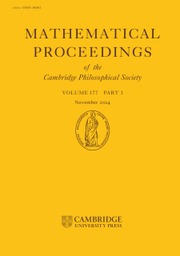Crossref Citations
This article has been cited by the following publications. This list is generated based on data provided by Crossref.
PRIYADARSHI, AMIT
2016.
CONTINUITY OF THE HAUSDORFF DIMENSION FOR GRAPH-DIRECTED SYSTEMS.
Bulletin of the Australian Mathematical Society,
Vol. 94,
Issue. 3,
p.
471.
Rigo, Michel
and
Stipulanti, Manon
2022.
Revisiting regular sequences in light of rational base numeration systems.
Discrete Mathematics,
Vol. 345,
Issue. 3,
p.
112735.
Baker, Simon
2022.
Equidistribution Results for Self-Similar Measures.
International Mathematics Research Notices,
Vol. 2022,
Issue. 16,
p.
12378.
Miculescu, Radu
Mihail, Alexandru
and
Urziceanu, Silviu-Aurelian
2022.
An application of Edelstein’s contraction principle: the attractor of a graph-directed generalized iterated function system.
Journal of Fixed Point Theory and Applications,
Vol. 24,
Issue. 3,
Dubey, Shivam
and
Verma, Saurabh
2024.
Inhomogeneous graph-directed attractors and fractal measures.
The Journal of Analysis,
Vol. 32,
Issue. 1,
p.
157.


